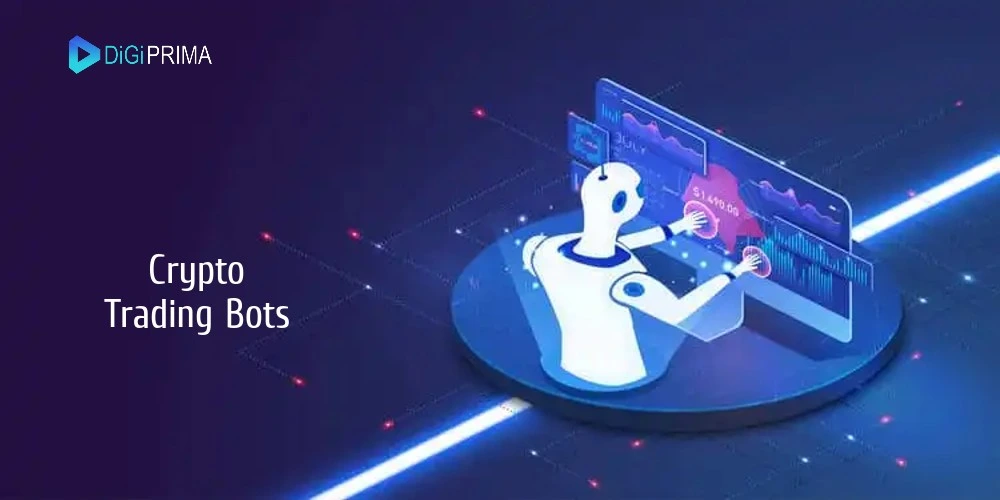Crypto Trading
Crypto Trading Bots
How Do Crypto Trading Bots Work?
Explain Different Bot Trading Strategies.
1. Market Making:
2. Trend Following :
3. Crypto Arbitrage Bot:
4. Mean Reversion:
5. Scalping:
6. Breakout Trading:
7. News-Based Trading:
How to Make a Crypto Trading Bot
Embark on a solo journey: Acquire an existing open-source bot through a download
There are various methods available for creating a crypto trading bot. One convenient and cost-effective option is to leverage existing open-source crypto bots. These readily available resources allow for a quick download and implementation, requiring minimal technical expertise and reducing development time and expenses.
Nevertheless, if you intend to incorporate custom features, conduct ongoing development, and address any potential bugs or security concerns, it becomes essential to retain the services of a skilled, dedicated software programmer. Although open-source bots provide a solid foundation, relying solely on them may limit your ability to implement unique features or tailor the trading algorithm to your specific requirements.
Build Crypto Trading Bot From Scratch:
Building a crypto trading bot from scratch involves the following steps:
- Define Your Trading Strategy: Determine the specific trading strategy you want your bot to follow. Consider factors such as indicators, entry and exit rules, risk management, and position sizing. Define the logic and parameters that will guide your bot's decision-making process.
- Choose a Programming Language: Select a programming language that suits your expertise and provides the necessary libraries and tools for interacting with cryptocurrency exchanges. Popular options include Python, JavaScript, or Ruby.
- Connect to a Cryptocurrency Exchange: Research and choose a reliable cryptocurrency exchange that offers an API for accessing market data and executing trades. Create an account on the exchange and obtain API keys for authentication.
- Set Up Development Environment: Install the necessary development tools, libraries, and frameworks for your chosen programming language. Set up a version control system to track code changes and collaborate effectively.
- Fetch Market Data: Use the exchange's API to retrieve real-time market data such as prices, order books, and trade history. Process and store this data for analysis and decision-making.
- Implement Trading Logic: Write the code to implement your defined trading strategy. Use the market data to generate buy and sell signals based on your indicators and rules. Consider risk management techniques, such as stop-loss orders and position sizing, to protect your capital.
- Test Your Bot: Create a simulated trading environment where you can test your bot's functionality and performance. Use historical market data to backtest your strategy and assess its profitability. Adjust and refine the code as needed.
- Deploy and Monitor: Deploy your bot to a server or cloud platform that allows it to run continuously. Implement logging and monitoring mechanisms to track its performance and receive notifications for trades and errors. Regularly monitor and evaluate its performance to make necessary adjustments.
- Stay Informed and Iterate: Stay updated with market trends, news, and regulatory changes that may impact your trading strategy. Continuously iterate on your bot's codebase, incorporating improvements and adapting to evolving market conditions.
Key considerations to remember when developing a crypto trading platform or bot
We talked about the major steps involved in building a crypto trading platform or Python Trading bot. You have to keep things in mind. Now let us talk about them, which are as follows:
1. Creating a Strong Growth Approach : When you start a software development project, you need a solid approach, and the same holds true for developing a crypto trading bot. Your development approach should include the following:
- Identifying the appropriate technology stack to use.
- Choosing the right frameworks, and open-source tools.
- Identifying the appropriate cloud platform.
- Building the right application security solutions.
- Deciding on testing and DevOps tools to use.
2. Preparation of a Comprehensive Project Plan :Success in this project requires effective planning. Your project plan needs to cover various aspects, for example:
- Management of business and non-functional requirements.
- Selecting the right SDLC methodology.
- creating a project schedule.
- Planning key aspects like risk management, communication management.
- quality management etc.
- Hiring and onboarding the right developers.
- metrics and measurement.
- stakeholder management.
3. Hiring the Right Developers : Hiring the right people is critical in any software development project.
You will have to interview the shortlisted candidates. Look for the appropriate skills, which will depend on your project requirements. You may need developers with the following skills:
- Thorough knowledge of programming languages such as Java, Python, JavaScript, etc.
- Good knowledge of relevant tools, frameworks, libraries etc.
- Expertise in appropriate cutting edge technologies like AI.



Leave your thought
Send us a Message
Contact Info
[email protected]
[email protected]
+91-62661-63663
[email protected]